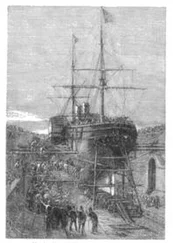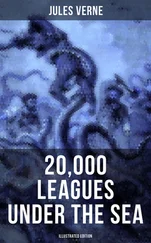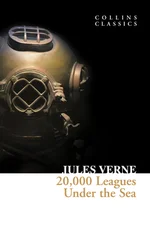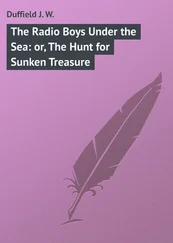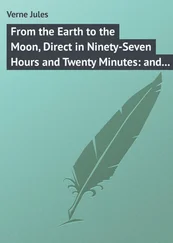Jules Verne - Twenty Thousand Leagues Under the Sea
Здесь есть возможность читать онлайн «Jules Verne - Twenty Thousand Leagues Under the Sea» — ознакомительный отрывок электронной книги совершенно бесплатно, а после прочтения отрывка купить полную версию. В некоторых случаях можно слушать аудио, скачать через торрент в формате fb2 и присутствует краткое содержание. Жанр: sf_writing, на английском языке. Описание произведения, (предисловие) а так же отзывы посетителей доступны на портале библиотеки ЛибКат.
- Название:Twenty Thousand Leagues Under the Sea
- Автор:
- Жанр:
- Год:неизвестен
- ISBN:нет данных
- Рейтинг книги:5 / 5. Голосов: 2
-
Избранное:Добавить в избранное
- Отзывы:
-
Ваша оценка:
- 100
- 1
- 2
- 3
- 4
- 5
Twenty Thousand Leagues Under the Sea: краткое содержание, описание и аннотация
Предлагаем к чтению аннотацию, описание, краткое содержание или предисловие (зависит от того, что написал сам автор книги «Twenty Thousand Leagues Under the Sea»). Если вы не нашли необходимую информацию о книге — напишите в комментариях, мы постараемся отыскать её.
Twenty Thousand Leagues Under the Sea — читать онлайн ознакомительный отрывок
Ниже представлен текст книги, разбитый по страницам. Система сохранения места последней прочитанной страницы, позволяет с удобством читать онлайн бесплатно книгу «Twenty Thousand Leagues Under the Sea», без необходимости каждый раз заново искать на чём Вы остановились. Поставьте закладку, и сможете в любой момент перейти на страницу, на которой закончили чтение.
Интервал:
Закладка:
The nets were hauled in. They were a large kind of "chaluts," like those on the Normandy coast, great pockets that the waves and a chain fixed in the smaller meshes kept open. These pockets, drawn by iron poles, swept through the water, and gathered in everything in their way. That day they brought up curious specimens from those productive coasts-fishing-frogs that, from their comical movements, have acquired the name of buffoons; black commersons, furnished with antenn?; trigger-fish, encircled with red bands; orthragorisci, with very subtle venom; some olive-colored lampreys; macrorhynci, covered with silvery scales; trichiuri, the electric power of which is equal to that of the gymnotus and cramp-fish; scaly notopteri, with transverse brown bands; greenish cod; several varieties of gobies, etc.; also some larger fish; a caranx with a prominent head a yard long; several fine bonitos, streaked with blue and silver; and three splendid tunnies, which, in spite of the swiftness of their motion, had not escaped the net.
I reckoned that the haul had brought in more than nine hundredweight of fish. It was a fine haul, but not to be wondered at. Indeed, the nets are let down for several hours, and inclose in their meshes an infinite variety. We had no lack of excellent food, and the rapidity of the Nautilus and the attraction of the electric light could always renew our supply. These several productions of the sea were immediately lowered through the panel to the steward's room, some to be eaten fresh, and others pickled.
The fishing ended, the provision of air renewed, I thought that the Nautilus was about to continue its submarine excursion, and was preparing to return to my room, when, without further preamble, the captain turned to me, saying:
"Professor, is not this ocean gifted with real life? It has its tempers and its gentle moods. Yesterday it slept as we did, and now it has woke after a quiet night. Look!" he continued. "It wakes under the caresses of the sun. It is going to renew its diurnal existence. It is an interesting study to watch the play of its organization. It has a pulse, arteries, spasms; and I agree with the learned Maury, who discovered in it a circulation as real as the circulation of blood in animals.
"Yes, the ocean has indeed circulation, and to promote it, the Creator has caused things to multiply in it-caloric, salt, and animalcul?."
When Captain Nemo spoke thus, he seemed altogether changed, and aroused an extraordinary emotion in me.
"Also," he added, "true existence is there; and I can imagine the foundations of nautical towns, clusters of submarine houses, which, like the Nautilus, would ascend every morning to breathe at the surface of the water-free towns, independent cities. Yet who knows whether some despot-"
Captain Nemo finished his sentence with a violent gesture. Then, addressing me as if to chase away some sorrowful thought:
"M. Aronnax," he asked, "do you know the depth of the ocean?"
"I only know, captain, what the principal soundings have taught us."
"Could you tell me them, so that I can suit them to my purpose?"
"These are some," I replied, "that I remember. If I am not mistaken, a depth of 8,000 yards has been found in the North Atlantic, and 2,500 yards in the Mediterranean. The most remarkable soundings have been made in the South Atlantic, near the 35th parallel, and they gave 12,000 yards, 14,000 yards, and 15,000 yards. To sum up all, it is reckoned that if the bottom of the sea were leveled, its mean depth would be about one and three-quarter leagues."
"Well, professor," replied the captain, "we shall show you better than that, I hope. As to the mean depth of this part of the Pacific, I tell you it is only 4,000 yards."
Having said this, Captain Nemo went toward the panel, and disappeared down the ladder. I followed him, and went into the large drawing-room. The screw was immediately put in motion, and the log gave twenty miles an hour.
During the days and weeks that passed, Captain Nemo was very sparing of his visits. I seldom saw him. The lieutenant pricked the ship's course regularly on the chart, so I could always tell exactly the route of the Nautilus.
Nearly every day, for some time, the panels of the drawing-room were opened, and we were never tired of penetrating the mysteries of the submarine world.
The general direction of the Nautilus was southeast, and it kept between 100 and 150 yards of depth. One day, however, I do not know why, being drawn diagonally by means of the inclined planes, it touched the bed of the sea. The thermometer indicated a temperature of 4.25 (Cent.); a temperature that at this depth seemed common to all latitudes.
At three o'clock on the morning of the 26th of November, the Nautilus crossed the Tropic of Cancer at 172 longitude. On the 27th instant it sighted the Sandwich Islands, where Cook died, February 14, 1779. We had then gone 4,860 leagues from our starting-point. In the morning, when I went on the platform, I saw, two miles to windward, Hawaii, the largest of the seven islands that form the group. I saw clearly the cultivated ranges, and the several mountain-chains that run parallel with the side, and the volcanoes that overtop Mouna-Rea, which rise 5,000 yards above the level of the sea. Besides other things the nets brought up were several flabellari? and graceful polypi, that are peculiar to that part of the ocean. The direction of the Nautilus was still to the southeast. It crossed the equator December 1, in 142 longitude; and on the 4th of the same month, after crossing rapidly and without anything particular occurring, we sighted the Marquesas group. I saw, three miles off, at 8 57' latitude south, and 139 32' west longitude, Martin's peak in Nouka-Hiva, the largest of the group that belongs to France. I only saw the woody mountains against the horizon, because Captain Nemo did not wish to bring the ship to the wind. There the nets brought up beautiful specimens of fish: choryphenes, with azure fins and tails like gold, the flesh of which is unrivaled; hologymnoses, nearly destitute of scales, but of exquisite flavor; ostorhyncs, with bony jaws, and yellow-tinged thasards, as good as bonitos; all fish that would be of use to us. After leaving these charming islands protected by the French flag, from the 4th to the 11th of December the Nautilus sailed over about 2,000 miles. This navigation was remarkable for the meeting with an immense shoal of calmars, near neighbors to the cuttle. The French fishermen call them hornets; they belong to the cephalopod class, and to the dibranchial family, that comprehends the cuttles and the argonauts. These animals were particularly studied by students of antiquity, and they furnished numerous metaphors to the popular orators, as well as excellent dishes for the tables of the rich citizens, if one can believe Athen?us, a Greek doctor, who lived before Galen. It was during the night of the 9th or 10th of December that the Nautilus came across this shoal of mollusks, that are peculiarly nocturnal. One could count them by millions. They emigrate from the temperate to the warmer zones, following the track of herrings and sardines. We watched them through the thick crystal panes, swimming down the wind with great rapidity, moving by means of their locomotive tube, pursuing fish and mollusks, eating the little ones, eaten by the big ones, and tossing about in indescribable confusion the ten arms that nature has placed on their heads like a crest of pneumatic serpents. The Nautilus, in spite of its speed, sailed for several hours in the midst of these animals, and its nets brought in an enormous quantity, among which I recognized the nine species that D'Orbigny classed for the Pacific. One saw, while crossing, that the sea displays the most wonderful sights. They were in endless variety. The scene changed continually, and we were called upon not only to contemplate the works of the Creator in the midst of the liquid element, but to penetrate the awful mysteries of the ocean.
Читать дальшеИнтервал:
Закладка:
Похожие книги на «Twenty Thousand Leagues Under the Sea»
Представляем Вашему вниманию похожие книги на «Twenty Thousand Leagues Under the Sea» списком для выбора. Мы отобрали схожую по названию и смыслу литературу в надежде предоставить читателям больше вариантов отыскать новые, интересные, ещё непрочитанные произведения.
Обсуждение, отзывы о книге «Twenty Thousand Leagues Under the Sea» и просто собственные мнения читателей. Оставьте ваши комментарии, напишите, что Вы думаете о произведении, его смысле или главных героях. Укажите что конкретно понравилось, а что нет, и почему Вы так считаете.

